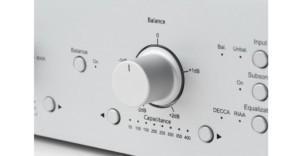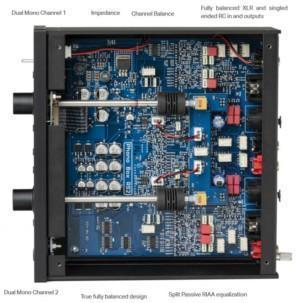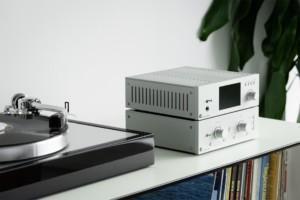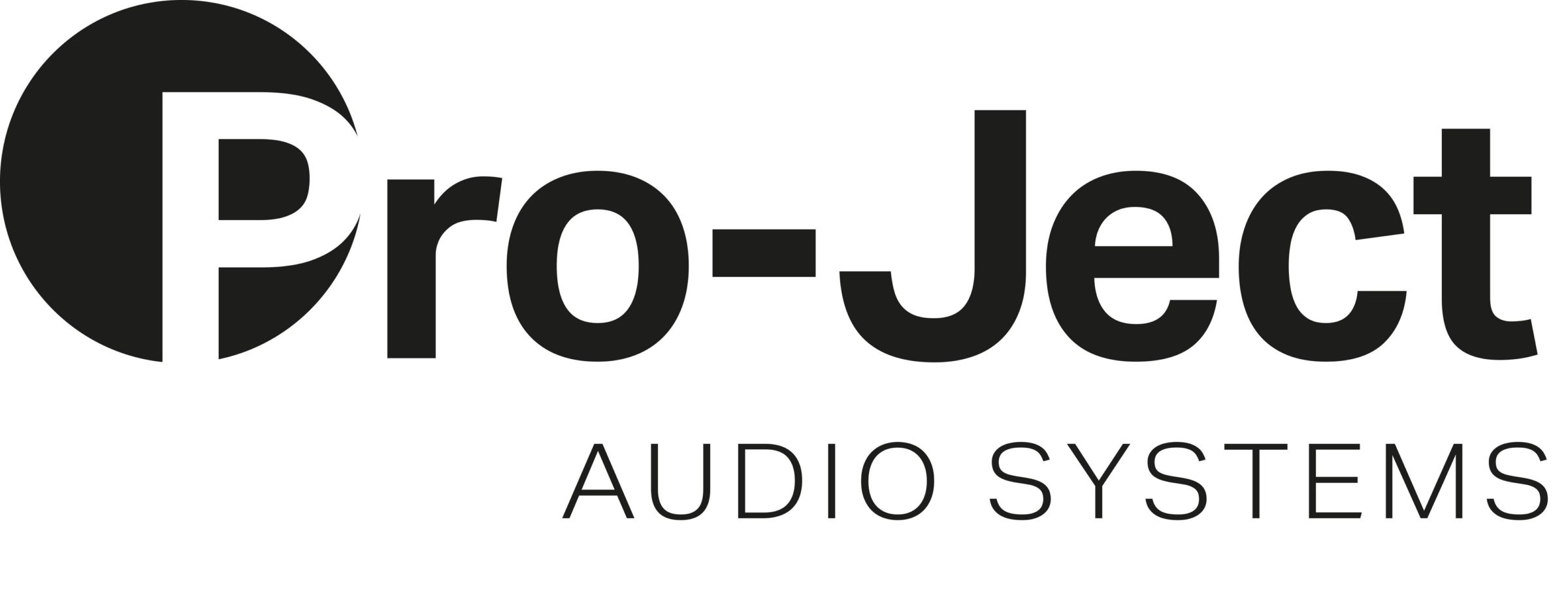Uusi, tasokas RIAA levysoitinesivahvistin. Pro-Jectin huippumalli.
Täysin balansoitu rakenne. XLR- ja RCA-sisääntulot ja lähdöt. RIAA- ja DECCA-toistokorjaukset. Balanssisäätö +- 2dB äänen tarkkaan säätämiseen. Sisääntulokohtaiset musitit säädöille (poislukien impedanssi ja balanssi). Portaaton impedanssin säätö MC-äänirasioille.
Tuplamonorakenne. Erilliskomponenttitoteutus. Laaja gain-säätöalue 40-70dB.
Musta ja hopea. Mitat 203x72x230mm (lev x kork x syv). Paino 1,6kg ilman virtalähdettä.
Reference class phono preamplifier with unique impedance control
The Phono Box RS2 is the ultimate phono preamplifier of the highest class. It is fully balanced from the input to the output. Electronics are fully discrete, no op-amps are in use and it uses split passive RIAA and DECCA equalization. An EQ has to be handled and implemented very carefully and split passive EQ is the most expensive way to do it, but also the only way to go if you want the most accurate sound.
The Phono Box RS2 features the most advanced controls to be seen on any phono preamp in this price class! It is an incredibly powerful tool for high-end enthusiasts and professionals who are looking to dive deep into all the settings and features the Phono Box RS2 has to offer. On the other hand, the top notch build quality, the clean circuit board design and the technology in use will let you enjoy your turntable and all it has to offer, even without digging too deep into the advanced settings. Purists can effortlessly enjoy the best sound while experts and tech-enthusiasts will find their perfect hightech phono preamp.
Discrete Circuitry
A discrete circuit is composed of electronic components which are disparate, individual devices, also called discrete components.
These can be “passive” components, like resistors, capacitors and inductors, as well as “active” components, which in our case are transistors. The opposite to this would be an integrated circuit, which uses operational amplifiers (Op-Amps) in the signal chain.
Countless hours of listening tests and years of experience have shown us that even the very best Op-Amps do not tend to be so neutral, natural, dynamic or vivid.
Standard phono pre-amplifiers with integrated circuits have a few tens or hundreds of components, but discrete designs will employ hundreds or thousands of components by comparison. That makes for an extended and more costly design process, but results in the best sound for your money.
Fully Balanced
The Phono Box RS2 employs a true fully balanced design principle. Balanced transmissions consist of a hot and a cold (also called + and -) signal. Both the + and – signal chains effectively carry the same musical information. A true balanced amplifier can now extract the final musical information out the +/- signals and subtract, remove, all noise that could potentially be added along the transmission.
A “pseudo-balanced” amplifier will not process the + and – signals independently, but add them together before they are processed. Pseudo-balanced design will not benefit from the advantages that balanced connections have to offer, like fully balanced amplifiers do. In a true, fully balanced amplifier, like the Phono Box RS2, the + and – sections of both the left and right channel are treated individually, which doubles the amplifier sections by 2 as a result. You need twice as much space on the circuit board, twice as many electrical components and be twice as careful with planning your circuit board layout. As a result, the Phono Box RS2 excels at suppressing unwanted noise, errors and interferences and offers the best signal to noise ratio possible.
Split passive EQ
The Phono Box RS2 uses split passive equalization for both of its RIAA and DECCA curves. This is more costly to design and implement but ensures the most accurate representation of the ideal EQ curve. Split passive equalization allows for better impedance matching and lower deviation from the ideal RIAA or DECCA curve.
Extreme cartridge loading options
Gain
No other phono-preamp in the world has such fine options of setting the gain like the Phono Box RS2. Very large ranges from 40dB (voltage amplification by 100x) up to 70dB (voltage amplification by 3690x) are possible. You can see the big increase in amplification between 40dB and 70dB and this is why a phono preamp must be incredibly silent (a fully balanced design makes a big difference here) to handle amplification levels this high. The Phono Box RS2 is able to do this just perfectly. You can perfectly match it with a wide variety of cartridges and perfectly integrate it into the rest of your Hifi system, matching the volume levels accurately to other sources like CD players or streaming devices.
Impedance
Load impedance can be set continuously via potentiometer, a system invented by Pro-Ject Audio Systems. It allows you to seamlessly adjust the impedance during playback and immediately assess the impact of different loading options. This is necessary to find just the right load impedance for your cartridge. No other manufacturers implement this feature in this extreme way.
Balance function
Cartridges, by nature, suffer from small imbalances bet-ween the left and right channels. To correct this the Phono Box RS2 introduces a new feature that is absolutely rare in this price category. A potentiometer allows you to adjust the exact center of the sound stage in ranges of 2dB to the left or right. This function can be switched off in order to keep the signal path as short as possible, or if it is not needed. For example, Ortofon declares that their very popular cartridge 2M Red has a channel balance of 1.5dB at 1kHz. Their very expensive MC cartridge Anna Diamond has a channel balance of, still, 0.5dB. The-se small differences can be accurately balanced by the Phono Box RS2.
Practically, there is no MM or MC cartridge that the Phono Box RS2 can’t handle.
Power Supply
The Phono Box RS2 is powered from an external adapter which is rated 20V/3A. If you have an amplifier where there is a 3500x voltage gain and the input sensitivity is a few hundred micro-volts (0,0001 Volt) you will definitively want to keep it as far away as possible from all sour-ces of interference which can harm the vulnerable signal from cartridge. That is why it is important to keep all the parts which can radiate electromagnetic fields out of the amplifier range. This is the reason why we are using an outboard power supply. Due to legal requirements, this power supply must be a switch mode type with guaranteed stand-by mode power consumption 0,1W.
Power Box RS2 Phono – linear power supply upgrade
An outboard power supply with linear construction is even better, because it can offer much cleaner power. When you want to manufacture such clean and really high-end power supplies, you have to use a transformer with a very low core saturation and preferably with shielding between primary and secondary windings. Low core saturation decreases radiation of the outer electromagnetic field which can be inducted into sensitive circuitry. Shielding between windings work as a very efficient filter which effectively suppresses interference from mains. When it is combined with a DC-blocker which avoids the saturation of a core by DC current, the resulting filtration is even better. The mechanical vibration of the transformer is also reduced. It is critical that the transformer in use is also vacuum impregnated. Obviously, such a transformer becomes larger than one would expect. Also, much more expensive. That is why such a power supply requires a cabinet the size of the Phono Box RS2 itself. The location of the power supply shouldn’t be close to Phono Box RS2. Additionally, the Phono Box RS2 shouldn’t be exposed to big transformers in power amplifiers or other appliances which can cause electromagnetic interference either. Strong electromagnetic fields from big transformers in very close proximity can even penetrate the heavy metal/aluminium chassis of the Phono Box RS2. Even a chassis like this has its limits! The best arrangement is to keep the Phono Box RS2 as far away as possible from those harmful electromagnetic fields.
An external linear power supply for the Phono Box RS2 will also power Pro-Ject turntables and be another step up in turntable and Phono Box RS2 performance.
Steel/aluminium chassis
The Phono Box RS2 has a steel chassis which is covered by screwed aluminium panels. This construction brings very good rigidity and splendid isolation against interferences. Working with hundredths of fractions of microvolts, everything is playing its role. Phono Box RS2 is available in silver or black.
” Luokkansa huippu! ” AV Plus (1/2021)

” Aarre aktiiviselle äänirasiaharrastajalle. Pro-Ject Phono Box RS2:n säätömahdollisuudet sisältävät toimintoja, joita useimmista sen lajitovereista ei löydy. …sen tarjoaman äänenlaadun otaksuisi riittävän vähän vaativammallekin vinylistille. ” Jaakko Eräpuu / HIFIMAAILMA (3/2021)
” Referenzklasse, Preis/Leistung: Uberragend ” AUDIO (3/2021)
” Mycket bra ljud ” HIFI & MUSIK (5/2021)

” Editor’s Choice, Sound quality 5 stars – Value for money 5 stars – Build quality 5 stars – Features 5 stars ” HI-FI CHOICE (Nov 2021)




